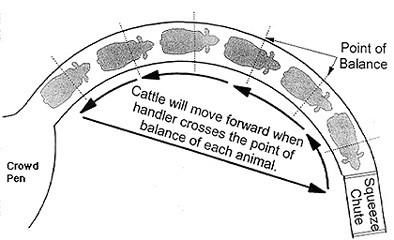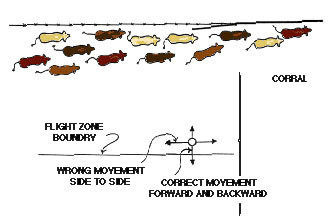There are a few concepts to understand before moving animals on the farm.
Most farm animals find security and feel safe within a group. Therefore, it is important not to move individual animals as this will make the animal feel vulnerable and stressed and the animal could become aggressive and defensive. Rather try to move a number of animals to the restraining area and after restraining the specific individual you can return the rest to the herd or wait for the procedure on the individual to be completed.
Most farm animals will try to flee (run away) as their first mean of defence. Therefore, livestock such as goats, sheep and cattle when moved from one area to the next by the man on foot, sheep & cattle dogs or on horseback, must always be done in a relaxed manner because if animals are exposed to too much noise they will become unmanageable and this could result in losses.
When approaching animals, it must be done from an angle as shown below.
This diagram illustrates the general flight zone of an animal. The actual flight zone of an individual animal will vary depending on how "tame” or calm the animal is. The flight zone gets bigger when an animal becomes excited or when approached “head-on” (from the front).
It is much easier to move calmed down cattle. If cattle become excited, it takes 20 to 30 minutes for them to calm down.

The handler’s movement pattern keeps cattle moving towards the squeeze chute in a curved crush system.

Using the principles of flight zone behaviour, a handler is able to move cattle into a pen in a calm and orderly way. Using the positions shown on this diagram will enable the handler to control the flow of cattle through the gate. Cattle movement can be slowed down or speeded up by moving forward or backwards.
Click here to view a video that explains the natural behaviour of dairy cattle.